
Phragmipedium is a genus of the Orchid family (Orchidaceae) and the only genus comprised in the tribe Phragmipedieae and subtribe Phragmipediinae. The name of the genus is derived from the Greek phragma, which means "division", and pedium, which means "slipper". It is abbreviated 'Phrag' in trade journals.

Stanhopea is a genus of the orchid family (Orchidaceae) from Central and South America. The abbreviation used in horticultural trade is Stan. The genus is named for the 4th Earl of Stanhope (1781-1855), president of the Medico-Botanical Society of London (1829-1837). It comprises 55 species and 5 natural hybrids. These epiphytic, but occasionally terrestrial orchids can be found in damp forests from Mexico to Trinidad to NW Argentina. Their ovate pseudobulbs carry from the top one long, plicate, elliptic leaf.
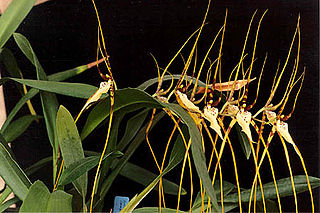
Brassia is a genus of orchids classified in the subtribe Oncidiinae. It is native to Mexico, Central America, the West Indies, and northern South America, with one species extending into Florida.
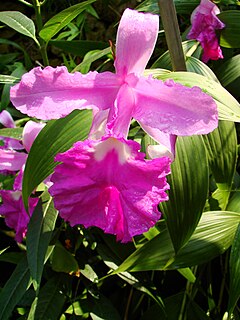
Sobralia is a genus of orchids native to Mexico, Central and South America. The plants are more commonly terrestrial, but are also found growing epiphytically, in wet forests from sea level to about 8,800 ft. The genus was named for Dr. Francisco Sobral, a Spanish botanist. The genus is abbreviated Sob in trade journals.

Schomburgkia is a genus of plants belonging to the family Orchidaceae. This genus is named for Richard Schomburgk, a German botanist who explored British Guiana during the 19th century. Species in this genus are either epiphytic or lithophytic in their growth habit. According to the Royal Horticultural Society Schom. is the official abbreviation for this genus.

Lockhartia, abbreviated Lhta. in the horticultural trade, is a genus of orchids and the only genus of alliance Lockhartia. There are about 30 species, distributed from Mexico through northern South America, as well as in Trinidad.

Huntleya is a small orchid genus native to South America, Central America and Trinidad.

Lycaste, abbreviated as Lyc in horticultural trade, is a genus of orchids that contains about 30 species with egg-shaped pseudobulbs and thin, plicate (pleated) leaves.

Trichosalpinx, commonly known as the bonnet orchid, is a genus of about 100 species of neotropical orchid. The genus is widespread across most of Latin America from northern Mexico to Bolivia, as well as the West Indies.

Cycnoches, abbreviated as Cyc. in the horticultural trade, is a genus of 34 currently accepted species of orchids native to South America, Central America and southern Mexico. Also called "swan orchids", they are epiphytes found in lowland and pre-montane forests.

Campylocentrum is a genus of rare orchids native to Mexico, the West Indies, Central America and South America. One species (C. pachyrrhizum) extends its range into Florida.
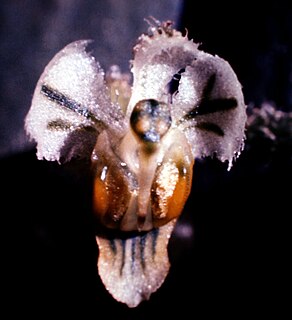
Ornithocephalus is a genus of orchids comprising more than 50 known species widespread in South America, Central America, Southern Mexico, Trinidad and the Windward Islands.
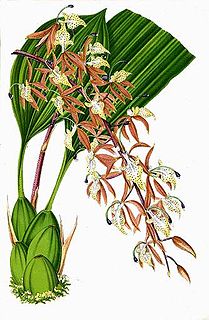
Polycycnis, abbreviated in horticultural trade as Pcn, is a genus of orchid, comprising 17 species found in Central America, and northern South America.

Sudamerlycaste locusta is a species of flowering plant in the family Orchidaceae.

Elleanthus is a genus of flowering plants from the orchid family, Orchidaceae. All the species are native to the warmer parts of the Western Hemisphere.

Fernandezia is a genus of flowering plants from the orchid family, Orchidaceae. It contains about 30-40 species, native to northern South America, Central America, and southern Mexico.

Trichoceros is a genus of flowering plants from the orchid family, Orchidaceae. The genus is endemic to South America.
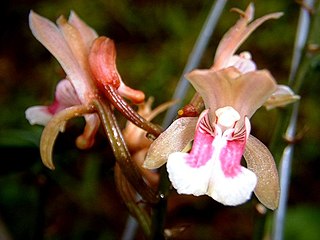
Oeceoclades, collectively known as the monk orchids, is a genus of flowering plants from the orchid family, Orchidaceae. It is related to Eulophia and like that genus is mostly terrestrial in habit. A few species extend into very arid environments, unusual for an orchid.

Pescatoria is a genus of flowering plants from the orchid family, Orchidaceae. It is native to Costa Rica, Panama, and northern South America.

Maxillariinae is an orchid subtribe in the tribe Cymbidieae. It was formerly treated as the tribe Maxillarieae, and divided into a number of subtribes.




















